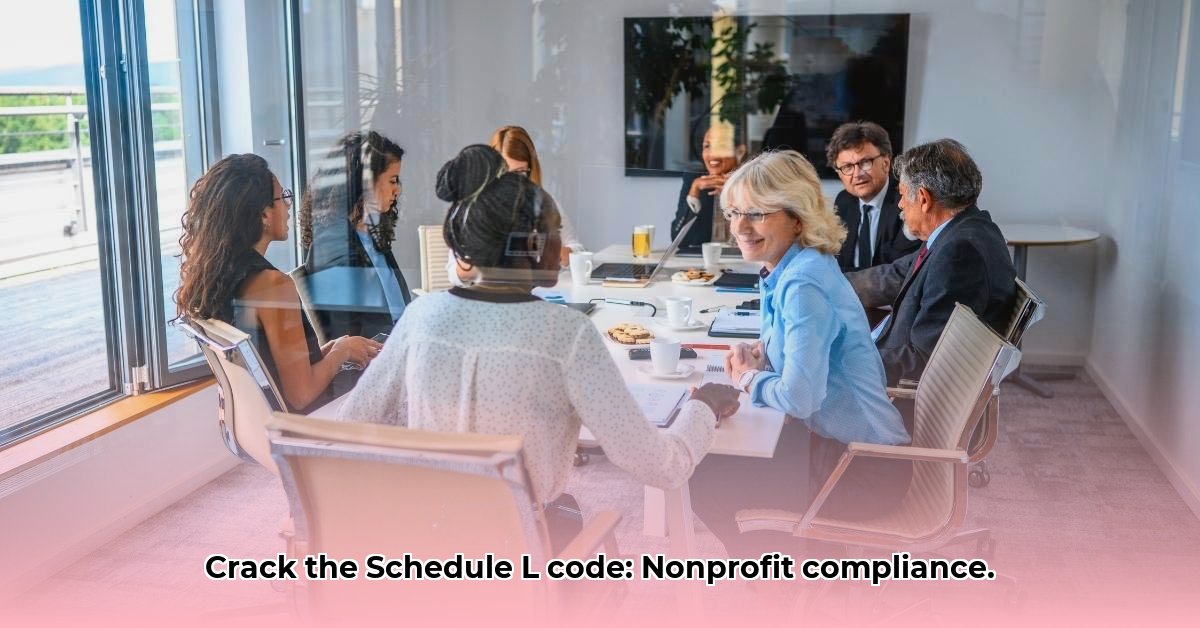
This comprehensive guide simplifies the complexities of IRS Form 990, Schedule L, providing clear instructions for reporting related party transactions. Accurate completion is crucial for maintaining your nonprofit's tax-exempt status and avoiding costly penalties. This guide will equip you with the knowledge and steps to complete Schedule L correctly. We’ll explore key definitions, reporting requirements, and best practices to ensure compliance.
Understanding "Interested Persons" and Reportable Transactions
Form 990, Schedule L, requires reporting transactions with "interested persons." This is a broader category than you might initially think. It includes individuals and entities who could significantly influence your organization's financial decisions or benefit from them.
Who is an "Interested Person"?
The IRS defines "interested persons" broadly. This typically encompasses:
- Officers and Directors: Individuals holding leadership positions within your nonprofit.
- Trustees: Individuals responsible for overseeing the organization's assets.
- Major Donors: Individuals or entities making substantial contributions.
- Family Members: Close relatives of officers, directors, trustees, and major donors.
- Related Organizations: Entities closely affiliated with your nonprofit (e.g., sister organizations).
- Business Partners: Businesses or individuals having significant business dealings with the organization.
Determining if a specific individual or entity qualifies as an "interested person" requires careful consideration of your organization's structure and relationships. The key is to identify individuals or entities with a potential personal stake in your nonprofit’s financial success.
What Transactions Require Reporting on Schedule L?
Schedule L mandates reporting on a range of financial interactions with interested persons. These include:
Loans: Any loans provided to or received from an interested person, regardless of the amount.
Grants: Financial aid provided to or received from an interested person.
Business Transactions: Contracts, sales, and other commercial agreements.
Compensation: Payments made to officers, directors, trustees, key employees, or their family members. This must be accurately reported in accordance with IRS guidelines.
Excess Benefit Transactions: These are transactions that give an interested person more than fair market value. Reporting is mandatory for all excess benefit transactions, regardless of size. This is a critical area for careful attention.
Did you know that failing to correctly report excess benefit transactions is a leading cause of penalties for nonprofits? Accurate reporting is paramount.
Step-by-Step Guide to Completing Schedule L
This section provides a clear, actionable plan for successfully completing Schedule L. Following these steps will help ensure accurate and complete reporting.
Identify Interested Persons: Begin by identifying all individuals and entities that meet the IRS definition of “interested persons.” Document your process.
Maintain Detailed Records: Keep thorough records of all transactions with interested persons. Include dates, amounts, descriptions, and any other relevant information for each transaction.
Categorize Transactions: Carefully categorize each transaction according to the instructions provided on Schedule L (loans, grants, etc.).
Complete the Form: Accurately transfer the data from your records to the correct lines on Schedule L. Review it thoroughly for accuracy.
Seek Professional Assistance (If Necessary): If you encounter ambiguities or complexities, consult a tax professional experienced with nonprofit tax compliance. This is particularly prudent for complex transactions.
Remember, meticulous record-keeping is the cornerstone of compliance. Your detailed documentation will support the information reported on Schedule L and provide a verifiable audit trail.
Reporting Thresholds and Privacy Considerations
While all excess benefit transactions must be reported regardless of amount, other transactions may have reporting thresholds. Consult the most current IRS instructions for the applicable amounts.
Furthermore, the IRS recognizes the need for protecting donor privacy. While transparency is vital, the use of generalized designations (like "substantial contributor 1," "substantial contributor 2," etc.) is permitted in certain circumstances. Refer to the latest IRS instructions for guidance.
Consequences of Non-Compliance and Best Practices
Failure to accurately complete Schedule L carries serious consequences, ranging from substantial penalties to the revocation of your tax-exempt status. Proactive steps are essential.
Proactive Compliance Best Practices:
Establish Clear Policies: Develop internal policies governing transactions with interested persons.
Regular Staff Training: Equip your team with up-to-date knowledge of IRS regulations.
Process Review: Periodically review your processes to ensure compliance with current guidelines.
Annual IRS Instructions Review: Make it a yearly practice to review the latest IRS instructions for Schedule L.
Professional Consultation: Don't hesitate to consult tax professionals specializing in nonprofit compliance.
By adhering to these guidelines, your nonprofit can ensure compliance with Schedule L requirements, maintaining its tax-exempt status and fostering public trust. Accurate reporting is not merely a legal obligation; it is a demonstration of your organization's commitment to transparency and sound financial management.